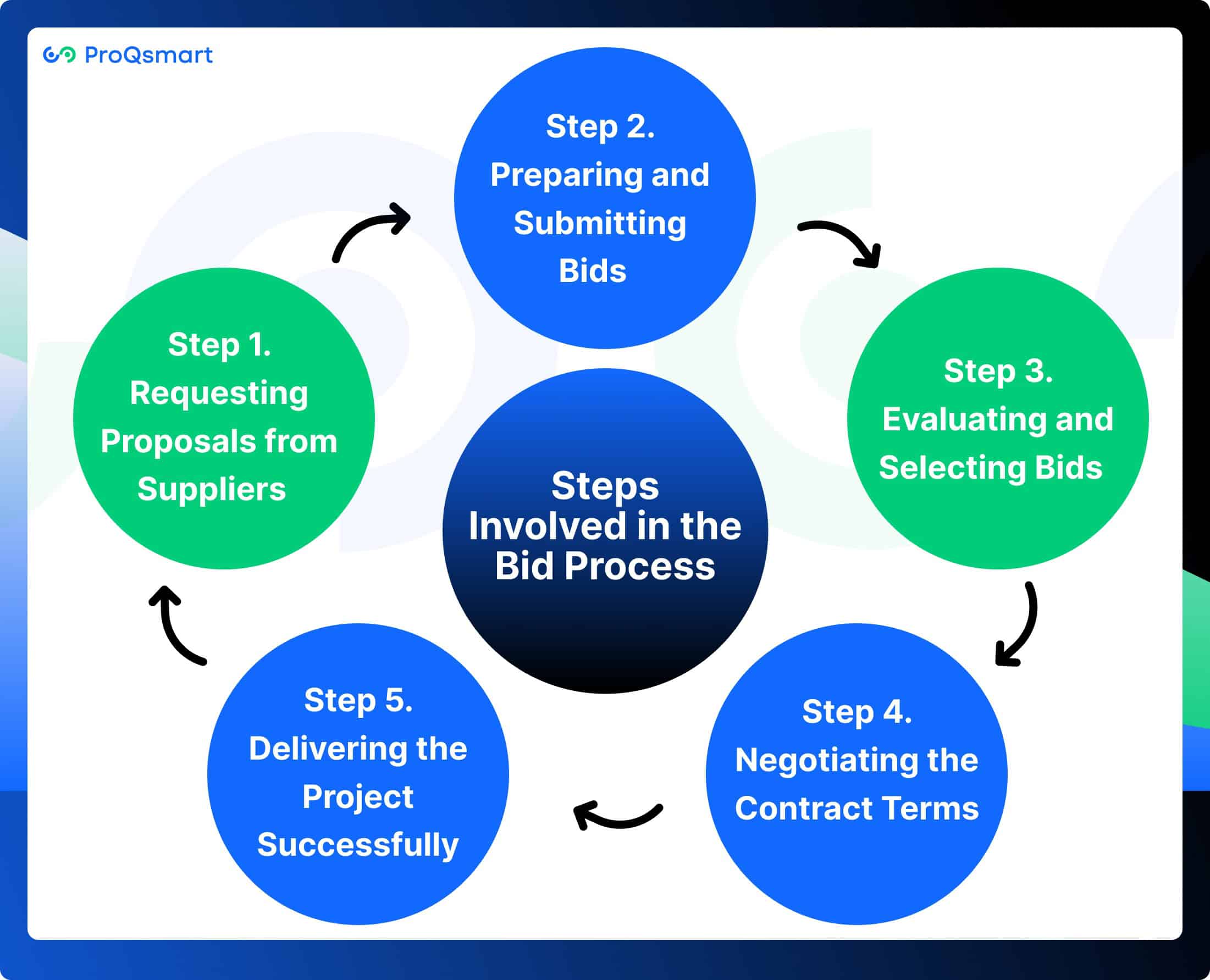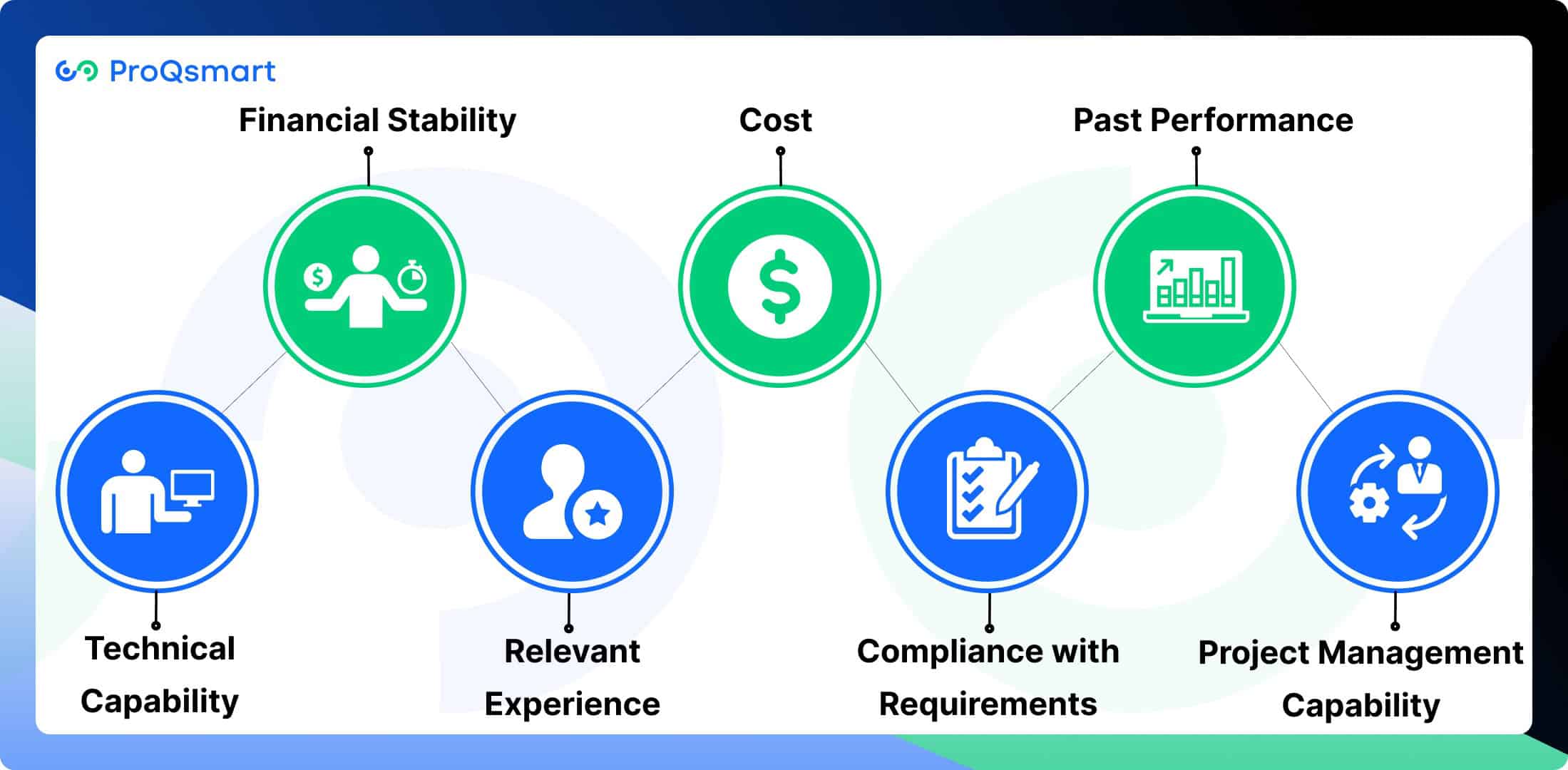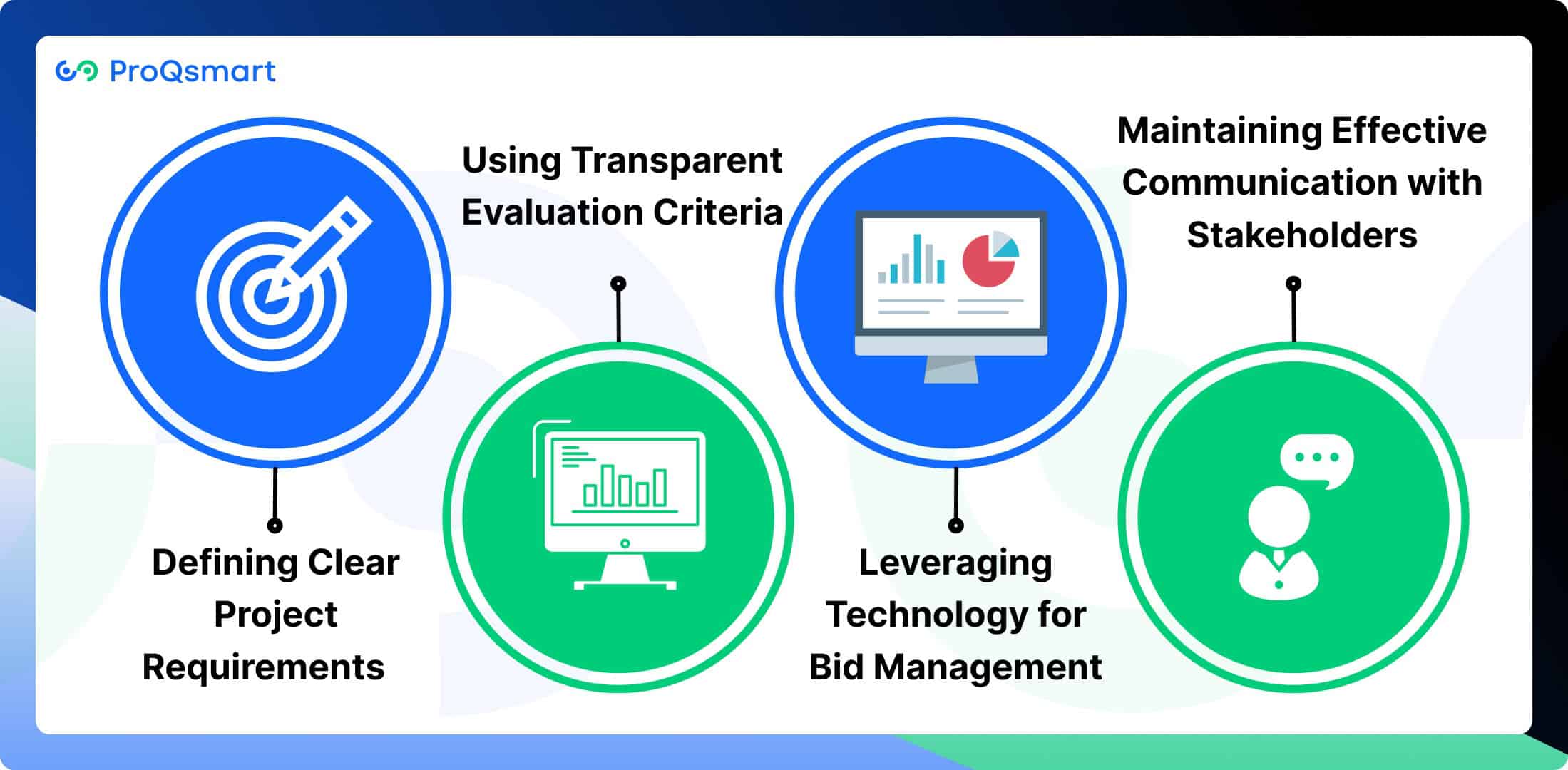The procurement bid process is an incredibly important part of recruitment, allowing organizations to find the best value and most reliable suppliers. It’s pretty complex, but it requires a very formalized process for soliciting, evaluating, and selecting proposals from potential vendors.
This important bid process maintains transparency, encourages healthy competition and assists businesses in finding the best value to meet their needs. Through transparent criteria, companies can avoid a lot of risk.
Second, by taking a systematic approach, they can ensure continued compliance with procurement requirements. Each one of these steps is significant.
From developing a request for proposal (RFP) through contract execution, we improve quality, lower costs, and increase service levels. For procurement professionals, getting the bid process down pat is central to streamlining supplier relationships and bolstering enterprise-wide strategic business results.
What is the Bid Process?

The bid process is a formal, standardized procedure used by organizations to request and evaluate bids from contractors or suppliers for goods, services, or construction projects. This structured approach helps large organizations identify suppliers that best meet their specific needs while promoting fairness and transparency throughout the engagement process.
Importance of the Bid Process in the Procurement
The bid process is essential for organizations seeking to procure goods and services efficiently and effectively. It serves several critical purposes:
Promotes Fair Competition: By inviting multiple suppliers to submit bids, the process fosters a competitive environment that can lead to better pricing and innovative solutions.
Ensures Transparency: A structured bid process helps maintain transparency in procurement activities, reducing the potential for favoritism or unethical practices. This transparency builds trust among stakeholders, including suppliers and internal teams.
Facilitates Informed Decision-Making: The systematic evaluation of bids allows organizations to make informed decisions based on a comprehensive analysis of proposals, rather than relying on subjective judgments.
Enhances Accountability: By formalizing procurement activities, the bid process creates a framework for accountability. Organizations can track decisions and ensure compliance with established policies and regulations.
What are Steps Involved in the Bid Process

The steps in the bid process for procurement are designed to facilitate the realization of these goals. The five primary stages are soliciting proposals, creating bids, bid evaluation, bid negotiation, and project award and delivery. Every stage is essential to ensuring procurement goals are met in a way that is equitable and transparent.
Step 1. Requesting Proposals from Suppliers
Organizations typically initiate this process by issuing an Invitation for Bid (IFB), Request for Quotation (RFQ), or Request for Proposal (RFP). Providing detailed information in these documents ensures that suppliers fully understand the project’s scope, budget, and timeline.
Pre-bid conferences play a vital role in this stage. These meetings offer suppliers the opportunity to ask questions and clarify expectations, significantly reducing the likelihood of mistakes and misunderstandings later in the process. By facilitating open communication between the procurement team and potential bidders, pre-bid conferences enhance transparency and foster a more competitive bidding environment. This proactive engagement ultimately leads to higher-quality proposals that align closely with the organization’s needs.
Step 2. Preparing and Submitting Bids
In the bid process, suppliers must ensure that their submissions are meticulously crafted and formatted according to the specified guidelines. Accurate pricing is essential, as competitive bids can significantly impact a supplier’s chances of securing the contract.
Suppliers should include comprehensive documentation to support their bids, such as engineering specifications, proposed schedules, and relevant experience. Understanding the client’s objectives is crucial for developing practical and achievable solutions that align with project requirements.
Additionally, it is important for suppliers to adhere to all submission guidelines, including deadlines and formatting instructions. A well-prepared bid not only reflects professionalism but also positions suppliers as reliable partners capable of delivering quality results.
Step 3. Evaluating and Selecting Bids
Evaluating bids is a critical step in identifying the proposal that offers the best value. This process relies on objective criteria, including cost, quality, and delivery schedules, to maintain fairness and transparency.
It is essential to assemble a diverse evaluation team with the necessary expertise to provide balanced perspectives. Given the significant financial stakes, particularly in capital-intensive sectors like construction, careful scrutiny of each proposal is crucial.
The evaluation begins with compliance checks to ensure all bids meet mandatory requirements. The team then assesses technical capabilities, past performance, and financial stability alongside pricing to determine overall value. Ultimately, the goal is to select the vendor that best aligns with the organization’s criteria while delivering optimal cost-effectiveness and quality.
Step 4. Negotiating the Contract Terms
Effective contract negotiation begins with establishing clear communication to set expectations from the outset. A degree of flexibility is essential, allowing both parties to explore their interests and reach a mutually beneficial agreement. Documenting all agreed-upon terms is critical to minimizing misunderstandings and reducing the likelihood of disputes. Successfully navigating this step lays a solid foundation for a productive partnership.
Step 5. Delivering the Project Successfully
Successful project delivery focuses on completing the defined scope within budget and on schedule. Maintaining consistent communication among all stakeholders fosters collaboration and facilitates the resolution of challenges as they arise.
Utilizing clear metrics and providing regular updates allows for effective progress tracking, ensuring accountability among all parties involved. This proactive risk management approach instills confidence that the project is on track to achieve its objectives.
What are the Criteria Involved in Bid Selection

When evaluating bids, organizations typically consider a range of criteria to ensure they select the most suitable supplier. Key factors for bid selection include:
Technical Capability: This involves assessing the bidder’s experience, understanding of the project requirements, proposed methodology, and the qualifications of key personnel. A minimum score is often set for technical proposals to ensure only qualified bidders advance to the financial evaluation stage.
Financial Stability: Bidders must demonstrate sufficient financial resources to undertake the project. This includes evaluating their annual turnover and overall financial health to ensure they can meet contractual obligations.
Relevant Experience: The bidder’s history with similar projects is crucial. Organizations often prefer bidders who have successfully completed projects of comparable scope and complexity, as this indicates reliability and expertise.
Cost: While cost is a primary factor, it is usually evaluated alongside other criteria rather than in isolation. The bid that offers the best overall value—considering both price and quality—is typically favored.
Compliance with Requirements: Bids must meet all specified requirements outlined in the solicitation documents. This includes adherence to timelines, quality standards, and any regulatory or legal obligations.
Past Performance: Evaluating a bidder’s previous performance on similar contracts can provide insights into their reliability and ability to deliver on time and within budget.
Project Management Capability: The bidder’s approach to managing the project, including their risk management strategies, communication plans, and resource allocation, is also assessed.
By considering these criteria, organizations can make informed decisions that align with their procurement objectives and ensure successful project outcomes.
Challenges in the Bid Process
Navigating the bid process in procurement often presents a series of complex challenges that can hinder efficiency and outcomes. By understanding these challenges in detail, procurement professionals can proactively address them, ensuring smooth operations and more successful project execution.
Managing Complex Project Specifications
One of the most significant challenges is handling detailed and often intricate project specifications. Overly complex or unclear requirements can overwhelm vendors, leading to misinterpretations or incomplete bids. To mitigate this, it is essential to streamline specifications while retaining critical details, ensuring vendors can respond accurately and effectively.
Engaging stakeholders early in the process can help clarify requirements and reduce the risk of misunderstandings. Additionally, implementing an ongoing review process allows for adjustments to specifications as project conditions evolve, ensuring they remain relevant and precise. For example, updating bid documents to reflect changes in site conditions or project scope can prevent costly errors and delays.
Handling High Volumes of Bids
A high volume of bid submissions can strain resources and prolong the evaluation process, delaying project timelines. To address this, leveraging digital tools and platforms can significantly enhance efficiency. These solutions can automate aspects of bid management, such as document organization, communication, and evaluation, while maintaining transparency and accuracy.
Establishing clear timelines and expectations for bid reviews is equally important. For instance, setting a structured review period ensures thorough evaluations without unnecessary delays. Automated scoring systems can further expedite the process, enabling teams to focus on strategic decision-making rather than administrative tasks.
Balancing Time, Cost, and Quality
Balancing competing priorities, such as cost, quality, and timelines, is a persistent challenge in the bid process. While cost savings are often a priority, compromising on quality or failing to meet deadlines can jeopardize project success. To navigate this, it is crucial to establish clear project objectives and priorities from the outset.
Engaging stakeholders in discussions about trade-offs ensures informed decision-making and alignment on project goals. For example, selecting a vendor with a slightly higher cost but a proven track record of reliability and quality can yield better long-term outcomes. By prioritizing value over the lowest bid, organizations can achieve a balance that supports both immediate and future project needs.
Best Practices for an Effective Bid Process

Defining Clear Project Requirements
Providing clear and consistent project requirements is the bedrock of an effective and competitive bid process. If your requirements are clear, vendors can make sure their proposal speaks to your particular needs and how they can address them. For example, if you outline the exact materials, delivery timelines, and quality standards for a construction project, vendors are more likely to provide accurate pricing and feasible solutions.
Stakeholder input is just as important in helping to hone these requirements. Involving teams from multiple disciplines helps to make sure that every detail is accounted for, from technical specifications to compliance requirements. Ambiguity, on the other hand, just invites poorly aligned submissions that almost always cost more and take longer.
Using Transparent Evaluation Criteria
Transparent evaluation criteria build trust and encourage competitive bids. When bidders understand how their proposals will be assessed—whether through cost, quality, or innovation—they are more likely to align their offers with your expectations. For instance, a bid for manufacturing equipment might prioritize energy efficiency alongside affordability.
Applying these criteria consistently across all submissions ensures fairness while reducing disputes. Transparency demonstrates professionalism, which can strengthen long-term partnerships.
Leveraging Technology for Bid Management
Leveraging technology for bid management simplifies complex processes, saving time and enhancing accuracy. Bid management software consolidates submissions, tracks deadlines, and streamlines evaluations in one centralized platform, significantly reducing manual errors.
Advanced analytics capabilities further improve decision-making by identifying trends and optimizing future bids. Additionally, a compliant content library serves as a single repository for reusable information, minimizing time spent on documentation.
For organizations looking to enhance their bid management processes, ProQsmart stands out as the best option to effectively manage every aspect of your bidding strategy. ProQsmart enhances the bidding process by offering features such as AI-powered vendor matching, which connects procurement needs with the most suitable suppliers, and live bidding capabilities that allow for real-time competitive pricing.
Maintaining Effective Communication with Stakeholders
Consistent, clear communication during the bid process goes a long way to keep everyone moving in the same direction. Frequent communication keeps all stakeholders up to date on progress and addresses any issues or changes in direction. For instance, posting answers to bidder questions or clarifications helps create transparency and avoid misunderstanding.
Additionally, responding to bidders’ inquiries in a timely manner shows professionalism and helps the overall process remain on track. A more strategic approach to communication saves countless hours and builds relationships that can lead to future successful collaborations.
Tips for Successful Bids
Here’s how to organize and execute a successful procurement bid. Every winning bid comes down to strategy, detail, and teamwork—especially in procurement. Below are essential tips to help you enhance your bid success:
Understand client needs
Prepare competitive and accurate proposals
Meet submission deadlines
By following these simple steps, you will set yourself up for success and help your bid stand out from the pack in today’s competitive marketplace.
Understanding the Client’s Needs
The first step in any great bid is knowing exactly what the client wants. Get inside their heads. First, read through the Request for Proposal (RFP) closely, and figure out what their goals, priorities, and pain points are.
Discussing your approach to the client to set clear expectations can uncover the clients’ preferences that are not clearly cited in the RFP. For instance, a large construction company could invest in sustainable practices for procuring materials.
By tailoring your proposal to help them achieve these objectives you’re ensuring that you’re doing exactly what they need most, making you much more competitive.
Preparing Competitive and Accurate Proposals
Generating a competitive proposal full of high quality, low price offerings is the name of the game. Make sure your pricing is clear and supported by realistic deliverables.
Buyers are not just interested in the lowest bid—they want reliable bidders. Show that you understand their situation and their client’s unique needs, and tailor your proposal accordingly.
Incorporating case studies of similar successful projects will make your bid much more competitive. Companies that have a centralized clearinghouse of previously created proposals make this process much easier, both saving time and ensuring accuracy.
Meeting Submission Deadlines
Submitting your bid in a timely manner shows that you’re a true professional. Missing deadlines can lead to late bids being disqualified, so make sure to leave yourself plenty of time in your schedule.
Helpful project management tools can help centralize tasks, track progress, and keep all parties accountable. If you submit early, you will have time to correct any technical difficulties that may arise.
Always plan for contingencies, like making sure team members have time to review submissions and catch mistakes.
Conclusion
The bid process is essential for effective procurement, fostering fair competition, promoting transparency, and ultimately delivering the best value to organizations. By understanding each step and adhering to transparent criteria, you can enhance efficiency while avoiding unnecessary complications. While challenges may arise, proper planning and proactive strategies can make them manageable.
Success in competitive bidding relies on clarity, informed decision-making, persuasive communication, and sound judgment. Continuously improving your processes and learning from each bid creates opportunities for forging new partnerships and driving meaningful change.
Embrace these lessons and implement them in your procurement strategy. Each action taken moves you closer to a more effective and streamlined process. To further enhance your bid management capabilities, consider leveraging ProQsmart. Its advanced features simplify the bidding process, ensuring you stay ahead in a competitive market. Book a demo today!
FAQs
What is the bid process in procurement?
The procurement bid process is a highly structured procedure. Agencies pro-actively solicit suppliers to bid on delivering goods or services. It helps to guarantee transparency, competition, and resulting value for taxpayer dollars.
How does ProQsmart streamline the bid process?
ProQsmart simplifies the bid process, allowing users to manage bids efficiently, compare proposals side-by-side, and ensure compliance effortlessly. This streamlined approach saves time and enhances overall efficiency, enabling organizations to make informed decisions quickly.
What are the key steps in the bid process?
The key stages include bid document preparation, bid invitation, bid evaluation, supplier selection and contract award. Every step protects against favoritism and collusion, and helps advance the procurement objectives of good value, transparency and accountability.
What challenges can arise during the bid process?
These challenges manifest as vague requirements, insufficient transparency from the supplier community, and decision-making delays. ProQsmart addresses all of these issues with cutting edge tools and features which minimize all of these risks.



